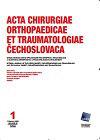全髋关节置换术后不稳定类型如何影响疗效?我们的经验(1999年至2020年)。
摘要
脱位是全髋关节置换术(THA)最常见的早期并发症之一。在这份手稿中,20年的经验与管理的这种并发症,特别是在不稳定的类型提出。材料与方法1999年1月至2020年12月期间,8286例THA患者中有157例(1.9%)发生至少一次脱位,其中原发性THA脱位117例(1.6%),改良THA脱位40例(3.4%)。在随访期间,几乎所有患者均采用前外侧入路手术。采用改进的Dorr分类对脱位类型进行评估。在首次脱位时,除了复位后髋关节明显错位、不复位或不稳定的情况外,通常选择保守入路。最小随访期为18个月(18-240)。采用标准统计学方法评价所选治疗方法的成功率。结果随访期间,原发性tha脱位率为1.6%,改良tha脱位率为3.4%。1999年至2009年的脱位率略高于随后的十年(2.1%对1.3%的原发性tha;p = 0.009)。最常见的脱位类型是体位性脱位(62%),其次是由多种原因引起的脱位(17%)和部件错位(11%)。130例脱位患者(130/157;83%)。尽管有21例(13%)患者实现了髋关节稳定,但功能结果不令人满意,有6例(4%)患者未能实现髋关节稳定。在位置型脱位中,首次脱位后闭合复位的成功率为86.4%,由于错位部件导致的首次脱位的再手术成功率相似(85.7%)。对于第二次脱位,无论脱位类型如何,手术治疗明显比闭合复位更可靠(78.6%对46%)。原发性髋关节置换术后脱位的治疗结果与改良髋关节置换术后脱位的治疗结果相当。总的来说,合并型脱位患者的预后最差。总共有11.5%的髋关节(18/157)需要移除THA。最终THA脱位的概率随着脱位顺序的增加而增加。在本组患者中,THA脱位率与已发表的数据相当或更低。随着时间的推移,我们通过使用预防措施,即高危患者的双活动杯或更大的头直径,成功地降低了脱位率。就像之前发表的系列文章一样,我们的患者中普遍存在位置型脱位,其次是部件错位引起的不稳定。改良的Dorr分类用于指导治疗,因为它不仅使我们能够对治疗方式做出正确的决定,而且在某种程度上也可以估计最终结果,特别是在恢复功能和稳定的髋关节方面。结论:原发性tha脱位率为1.6%,改良tha脱位率为3.4%。初次位型脱位应保守处理。相反,在其他类型的脱位和复发性脱位中,手术治疗更有可能获得良好的临床结果。最糟糕的结果是由于多种原因导致的不稳定,这比其他类型的脱位更容易导致THA的切除。此外,随着时间的推移,预防措施对高危患者的益处已得到证实。关键词:全髋关节置换术,脱位,Dorr分型,治疗策略,疗效,并发症。PURPOSE OF THE STUDY Dislocation is one of the most common early complications of total hip arthroplasty (THA). In this manuscript, 20 years of experience with the management of this complication are presented, particularly in relation to the type of instability. MATERIAL AND METHODS In the period between January 1999 and December 2020, at least one dislocation occurred in 157 of 8 286 (1.9%) THA patients, of which 117 dislocations (1.6%) in primary and 40 (3.4%) in revision THAs. Almost all patients were operated on from the anterolateral approach during the follow-up period. The type of dislocation was evaluated using the modified Dorr classification. In the first dislocations, conservative approach was usually opted for, except for cases with a clear malposition, irreducible or unstable hips after the reduction. The minimum follow-up period was 18 months (18-240). The success rate of the chosen treatment approach was assessed by means of standard statistical methods. RESULTS The total dislocation rate in the follow-up period was 1.6% for primary THAs and 3.4% for revision THAs. The dislocation rate was slightly higher between 1999 and 2009 compared to the following decade (2.1% versus 1.3% for primary THAs; p=0.009). The most common type of dislocation was the positional dislocation (62%), followed by dislocations due to a combination of causes (17%) and component malposition (11%). Treatment of dislocation was successful in a total of 130 patients (130/157; 83%). Even though a stable hip was achieved in 21 patients (13%), the functional outcome was unsatisfactory, and in 6 patients (4%) we failed to achieve a stable hip. In the positional type of dislocation, the success rate of closed reduction following the first-time dislocation was 86.4% and a similar success rate was reported for reoperations in the first-time dislocations due to the malpositioned components (85.7%). In the second-time dislocation, the surgical therapy was significantly more reliable compared to closed reduction regardless of the type of dislocation (78.6% versus 46%). The treatment of dislocations following primary THAs showed comparable outcomes to those of the treatment of dislocations following revision THAs. Overall, the worst outcomes were achieved in patients with a combined type of dislocation. In total, the THA had to be removed in 11.5% of hips (18/157). The probability of final THA removal increased with the increasing order of dislocation. DISCUSSION In our group of patients, the dislocation rate in THA was comparable or lower than the published data. With the use of preventive measures, i.e. dual mobility cup or larger head diameters in high-risk patients, we managed to reduce the dislocation rate over time. The positional type of dislocation prevails in our group of patients just as in the previously published series, followed by instability from malposition of components. The modified Dorr classification is used to guide the treatment since it allows us not only to make good decision about the treatment modality but to some extent also to estimate the final outcome, particularly with respect to restoring a functional and stable hip. CONCLUSIONS The total dislocation rate was 1.6% for primary THAs and 3.4% for revision THAs. The first-time dislocation of the positional type shall be treated conservatively. Conversely, in the other types of dislocations and in recurrent dislocations, surgical treatment is more likely to achieve a good clinical outcome. The worst outcomes are to be expected in an instability due to combination of multiple causes, which leads to the removal of THA more often than in other types of dislocations. Also, the benefit of preventive measures in high-risk patients over time has been confirmed. Key words: total hip arthroplasty, dislocation, Dorr's classification, treatment strategy, outcomes, complications.

 求助内容:
求助内容: 应助结果提醒方式:
应助结果提醒方式:


